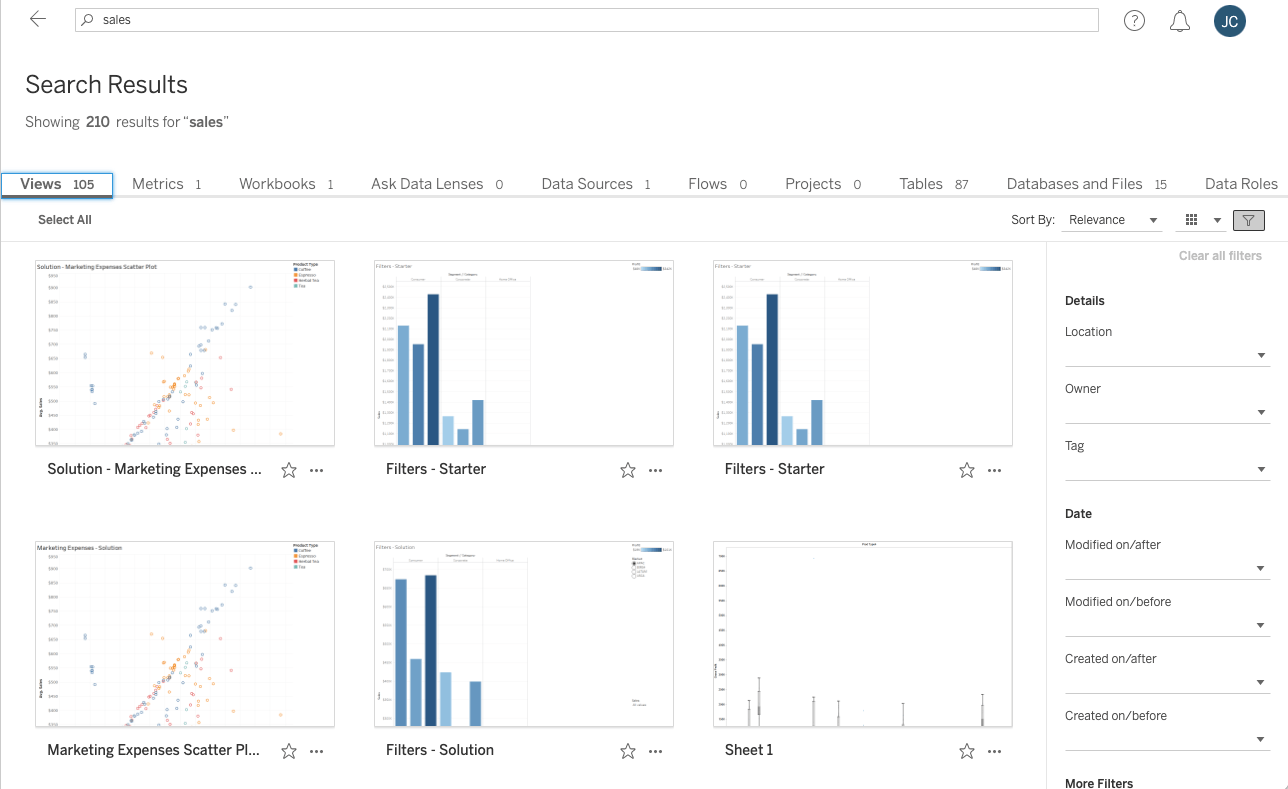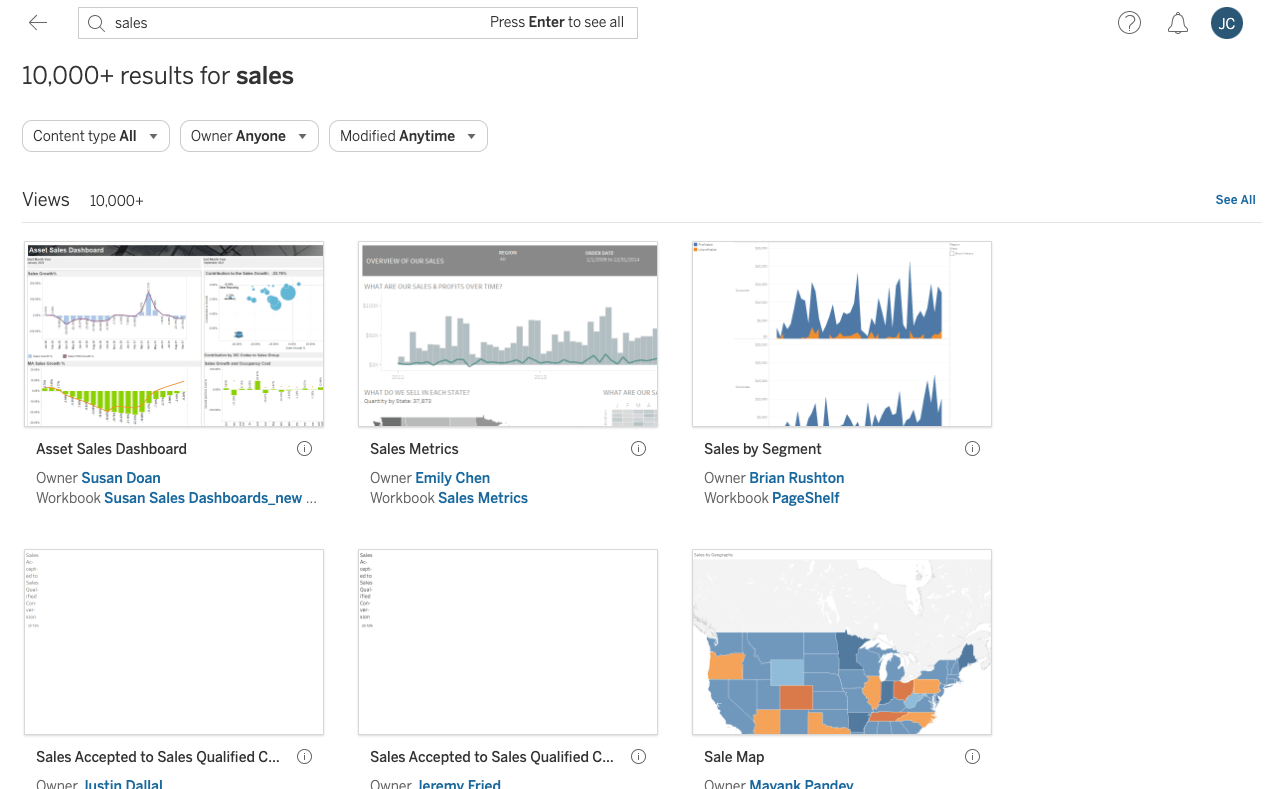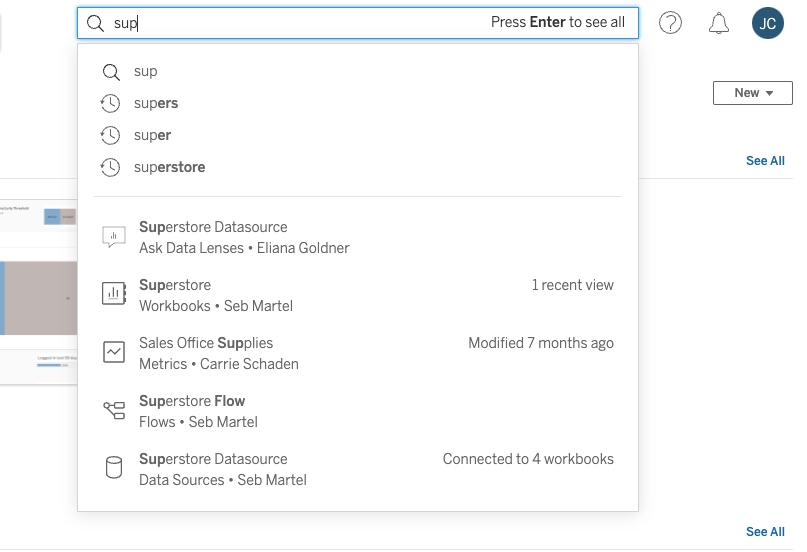The Evolution of Tableau Search and Best Practices for Finding Relevant Content
If a tree falls in a forest and no one is around to hear it, does it make a sound? On the Search team at Tableau, we like to ask, “If an analyst builds a beautiful visualization, but no one can find it, does it have any value?”
Analytical content is only as useful as its availability and discoverability to relevant stakeholders and consumers. And with the amount of analytical content in your analytics environment growing every day, it’s hard to discover—and even rediscover—the content that’s relevant to you.
To help you self-serve useful insights in the natural flow of your work, the Tableau search experience aspires to be intuitive, flexible, and personalized. Achieving this vision will be a continued journey, but a series of functional and UI improvements across recent releases is making it easier for customers to find and discover relevant content in Tableau Server and Tableau Cloud.
At this stage, I’d like to acknowledge where we have come from, where we have yet to go, and offer some tips to help you make the best of the search capabilities available to you.
The evolution of Tableau search capabilities
Intuitive
Before Tableau 2021.4, the search experience was highly constrained, providing exact matching on a handful of content types. The system was ineffective at distinguishing between relevant and irrelevant results, and getting you to the right information required lots of clicks, scrolling, and query reformulations.

Then, with the Tableau 2021.4 release, search took a leap forward. A refreshed UI and simplified sorting and filter capabilities decreased the amount of clicks and scrolling needed to navigate to the content that you were looking for.

In the Tableau 2022.1 release, the Search team delivered functional changes to the search retrieval and ranking algorithms to improve the overall relevance and quality on the Search Results Page. To understand these changes, it’s helpful to know how content is indexed for search.
When a piece of content is processed into the Search Index, the words contained in a select set of fields (e.g title and description) are converted into “tokens.” There are a number of standard text processing steps that convert text to tokens, but in general, you can think of a token as a meaningful word from a field in a piece of content. As an example, a workbook titled “2020 Superstore Sales in Chicago” would produce the following four tokens: “2020”, “superstore”, “sale”, and “chicago”.
Previously, when a user executed a query, the system would return content if the query matched on a portion of a whole token. For example, typing the query “super” would still return the content that contained a token for “superstore”.
Starting with Tableau 2022.1, the Search Results page only supports fuzzy matches on whole tokens. A query for “super”, would not match on a token “superstore”, but queries for “superstore”, “supertor”, “sperstore”, or “SuPerStores“ would match. The primary benefit of this change is that it reduces noise in the system and makes it more likely that you will get the results you expect.
Introducing Quick Search
In Tableau 2022.2, you will continue to see fresh new UIs, namely in the new Quick Search experience. Quick Search empowers you to more quickly find and discover the content you need to do your job, and it includes two exciting new features: Mixed Content Suggestions and Past Queries.

Our simplified content suggestions design dynamically suggests and links to relevant content as you type. In the old experience, the order of content suggestions was fixed by content type—views, followed by workbooks, followed by metrics, and so on. Now, you get relevant content suggestions in order, independent of content type. These suggestions are powered by a new Content Suggestions API and a newly tuned ranking algorithm.
Partial token matching will continue to be supported in Quick Search. In an upcoming release, we plan to adapt the logic in the Search Results Page, such that the results you see are the superset of content returned in Quick Search and the Search Results Page. This change will particularly benefit our customers who use languages that contain compound words.
Flexible
In Tableau 2022.2, a public REST API enables customers and partners to build custom experiences that pull Tableau content into the surface of their choice. The search team is using this same API for an internal use case of delivering a Tableau search experience from within Slack, which is planned for a future release within the next year. The Search team will continue to build on this theme of flexibility, and expose more functionality as APIs for customers and partners to leverage in creative and unique ways.
Personal
From our user research, we know that roughly half of the time you’re searching for content, you’re looking for content that you have already seen. With Past Queries, the system suggests your previously used queries if they match against the characters you are typing. Search displays your most relevant past queries using an algorithm that evaluates queries’ “frecency”—how frequently you issue a query and how recently you issued a query.
Personalized digital experiences have become ubiquitous, and we will hold Search in Tableau to this standard by designing an experience that adapts to your unique usage patterns. Starting in Tableau 2022.3, you’ll experience more personalization infused into the search experience. The ranking algorithms have been revamped to incorporate signals about the content that you’ve viewed and favorited. Additionally, we’re improving the ability to predict new content that you may be interested in by checking the authors and owners that you tend to prefer.
How to find relevant content in Tableau: tips for searching and exploring
Here are a few suggestions to help you quickly find the content you are looking for:
- Use complete words in your search query. This will increase the likelihood that you find what you’re looking for via better token matching.
- Search for words that are present in the title or description of a piece of content. If your organization has standards around naming conventions for content, it’s helpful to be familiar with them to make your searches more accurate.
- For content you want to revisit, mark it as a favorite by clicking the star icon. Now, it will show up in your Favorites page in the navigation panel so you can find it quickly, without having to search for it. And beginning with Tableau 2022.3, content you have favorited will be boosted to the top of your search results.
- Explore Recommendations to find new views that may be relevant to you. Starting with Tableau 2022.3, recommended views are also boosted in search results to help you discover new content.
Tableau makes it easy for organizations to produce insights from data. Tableau Search is making it easy to find and discover those insights.









